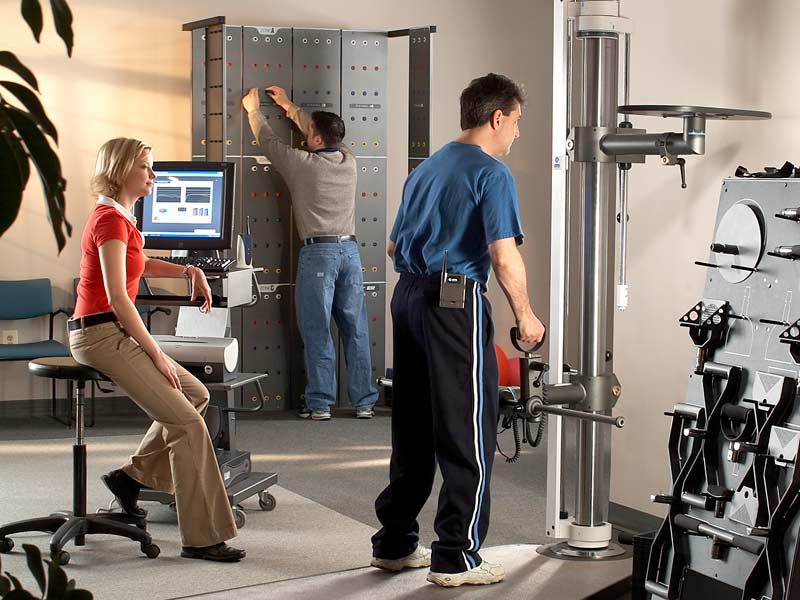Written by Laura on May 30, 2013 |

A functional capacity evaluation (FCE) is an objective, functional evaluation of a series of tests administered to help determine current functional and physical status of a patient/client. Not all worker compensation cases need a FCE. Some injuries don’t limit work duties and many times physical and/or occupational therapy provides the healing and assistance to return a patient to work safely. But there are many benefits of a FCE:
Continue Reading »
Written by Laura on May 20, 2013 |
 Industrial rehabilitation is a type of rehabilitation program aimed at helping an injured workers return to work safely and effectively and to help with prevention and reduction of work-related injuries. We must remember that industrial does not automatically mean that it is labor intensive. It includes jobs that are repetitive or that may involve awkward positions or motions. This type of program may include some if not all of the following types of programs/tests: physical and/or occupation therapy (worker compensation focused), Functional Capacity Evaluations (FCE), Work Conditioning, Work Hardening, Ergonomics, Job-Site Analysis, or Post-Offer Employment Test (POET).
Industrial rehabilitation is a type of rehabilitation program aimed at helping an injured workers return to work safely and effectively and to help with prevention and reduction of work-related injuries. We must remember that industrial does not automatically mean that it is labor intensive. It includes jobs that are repetitive or that may involve awkward positions or motions. This type of program may include some if not all of the following types of programs/tests: physical and/or occupation therapy (worker compensation focused), Functional Capacity Evaluations (FCE), Work Conditioning, Work Hardening, Ergonomics, Job-Site Analysis, or Post-Offer Employment Test (POET).
Continue Reading »
Written by Josh on May 8, 2013 |

ProActive Physical Therapy and Sports Medicine prides itself in providing patient care that is focused on returning a patient to his/her previous level of function. It may be a patient who needs to tolerate sitting at a computer work station for 8 hours a day, a grandmother who wants to hold her grandchildren free of debilitating back pain, or the athlete who wants to return to her/his sport ASAP. This article will focus on returning the athlete to his/her previous level of function for a specific sport.
Continue Reading »
Written by Josh on May 2, 2013 |
 Ever have neck and low back pain with pain and/or tingling and numbness down one or both arms or legs? If you have experienced this, you could have spinal stenosis. Spinal stenosis is a broad term that refers to any decrease in the openings in the spinal canal; it can occur along the entire length of the spine. The most common areas for its occurrence are in the cervical spine (neck) and the lumbar spine (low back) regions. Spinal stenosis can occur in the central spinal canal, putting pressure on the spinal cord, causing central stenosis. Lateral stenosis, where the spinal nerves exit the central spinal canal laterally, through openings called spinal foramina, is the most common form of spinal stenosis.
Ever have neck and low back pain with pain and/or tingling and numbness down one or both arms or legs? If you have experienced this, you could have spinal stenosis. Spinal stenosis is a broad term that refers to any decrease in the openings in the spinal canal; it can occur along the entire length of the spine. The most common areas for its occurrence are in the cervical spine (neck) and the lumbar spine (low back) regions. Spinal stenosis can occur in the central spinal canal, putting pressure on the spinal cord, causing central stenosis. Lateral stenosis, where the spinal nerves exit the central spinal canal laterally, through openings called spinal foramina, is the most common form of spinal stenosis.
Continue Reading »



 Industrial rehabilitation is a type of rehabilitation program aimed at helping an injured workers return to work safely and effectively and to help with prevention and reduction of work-related injuries. We must remember that industrial does not automatically mean that it is labor intensive. It includes jobs that are repetitive or that may involve awkward positions or motions. This type of program may include some if not all of the following types of programs/tests: physical and/or occupation therapy (worker compensation focused), Functional Capacity Evaluations (FCE), Work Conditioning, Work Hardening, Ergonomics, Job-Site Analysis, or Post-Offer Employment Test (POET).
Industrial rehabilitation is a type of rehabilitation program aimed at helping an injured workers return to work safely and effectively and to help with prevention and reduction of work-related injuries. We must remember that industrial does not automatically mean that it is labor intensive. It includes jobs that are repetitive or that may involve awkward positions or motions. This type of program may include some if not all of the following types of programs/tests: physical and/or occupation therapy (worker compensation focused), Functional Capacity Evaluations (FCE), Work Conditioning, Work Hardening, Ergonomics, Job-Site Analysis, or Post-Offer Employment Test (POET).
 Ever have neck and low back pain with pain and/or tingling and numbness down one or both arms or legs? If you have experienced this, you could have spinal stenosis. Spinal stenosis is a broad term that refers to any decrease in the openings in the spinal canal; it can occur along the entire length of the spine. The most common areas for its occurrence are in the cervical spine (neck) and the lumbar spine (low back) regions. Spinal stenosis can occur in the central spinal canal, putting pressure on the spinal cord, causing central stenosis. Lateral stenosis, where the spinal nerves exit the central spinal canal laterally, through openings called spinal foramina, is the most common form of spinal stenosis.
Ever have neck and low back pain with pain and/or tingling and numbness down one or both arms or legs? If you have experienced this, you could have spinal stenosis. Spinal stenosis is a broad term that refers to any decrease in the openings in the spinal canal; it can occur along the entire length of the spine. The most common areas for its occurrence are in the cervical spine (neck) and the lumbar spine (low back) regions. Spinal stenosis can occur in the central spinal canal, putting pressure on the spinal cord, causing central stenosis. Lateral stenosis, where the spinal nerves exit the central spinal canal laterally, through openings called spinal foramina, is the most common form of spinal stenosis.